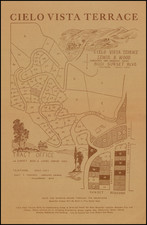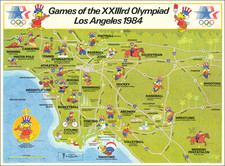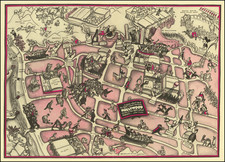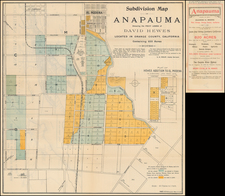This 1927 map delineates Los Angeles County and parts of Orange County, California, showcasing the area's topography and infrastructure, including railroads, highways, and municipal boundaries. The map was produced by R. A. McNally, a representative of Rand McNally & Company, and is one of scarcer and more attractive folding maps of Los Angeles produced during the 1920s.
During the 1920s, Los Angeles witnessed significant urban expansion and transformation, becoming a pivotal center for the burgeoning American entertainment industry, aviation, and oil businesses. This period, known as the Roaring Twenties, saw extensive development in transportation and infrastructure to support the rapidly growing population and economy. The map's depiction of steam and electric railroads, paved boulevards, and municipal boundaries offers a good window into the region's development during this dynamic period of American history.
The map's execution, with its use of light orange, green, blue, and black, reflects the period's aesthetic sensibilities and technological capabilities in cartographic representation. It is a clear and organized depiction of the area's geography, including notable elevations, forest reserves, and rancho boundaries, which are crucial for understanding the land distribution and natural landscape of Southern California during that time.
The map includes a black and white outline map of northern Los Angeles in the lower left corner.
Rand McNally & Co. is a large American map and navigation company best known for its annual atlases. The company got its start in 1856, when William Rand opened a print shop in Chicago. He was joined in 1858 by a new employee, Andrew McNally. Together, the men established their namesake company in 1868. Originally, the company was intended to print the tickets and timetables for the trains running to and through Chicago; their first railway guide was published in 1869.
By 1870, they had shifted from just printing to publishing directories, travel guides, and newspapers. Their first map appeared in 1872 in a railway guide. The map was produced using a new wax engraving method, a cheaper process that gave the company an edge.
By 1880 Rand McNally had entered the education market with globes, wall maps, and geography texts for students. In 1923, Rand McNally published the first Goode’s World Atlas, named after its editor, Dr. J. Paul Goode. For generations afterward, this would be the standard classroom atlas.
In 1899, William Rand left the company, but McNally and his family remained, controlling the company for over a century. In 1904, they published their first road map intended for automobiles and by 1907 were publishing Photo-Auto Guides, which combined photography and mapping to help drivers. In 1924, they produced the Auto Chum, a precursor to their famous road atlases. Rand McNally would remain the leader in road maps and atlases throughout the twentieth century.
In 1937, Rand McNally opened its first store in New York City. Ever on the frontier of technology, Rand McNally pioneered the scribing process for printing tickets in 1958 and printed their first full-color road atlas in 1960. Arthur Robinson developed his now-famous projection of Rand McNally in 1969. By the 1980s, the company was exploring digital reproduction and digital databases of maps for truckers. In the 1990s, they lead the charge to develop trip-planning software and websites. Today, most of its products are available online or in a digital format, including maps for tablets and phones.















![[ Orange County ] Geological Sketch Map S.E. Portion of Orange Co. California State Mining Bureau . . .](https://storage.googleapis.com/raremaps/img/small/76946.jpg)
